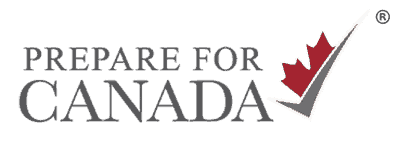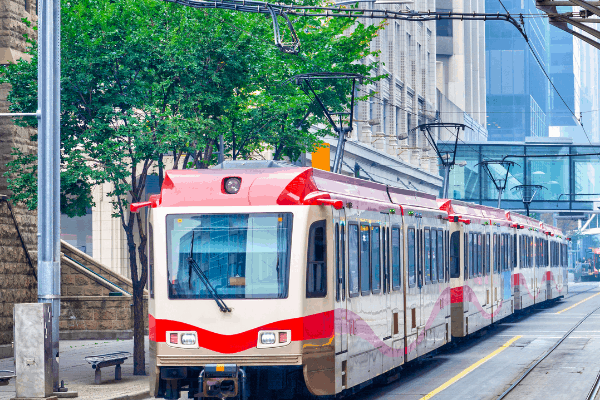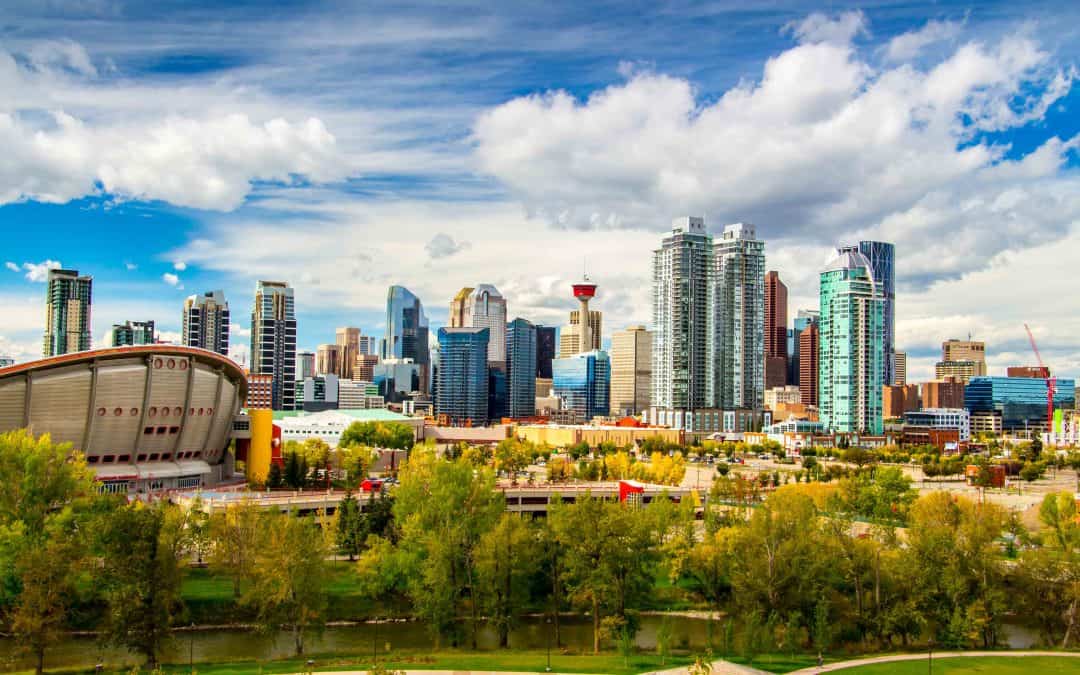
What to Know About Living In Calgary, Alberta
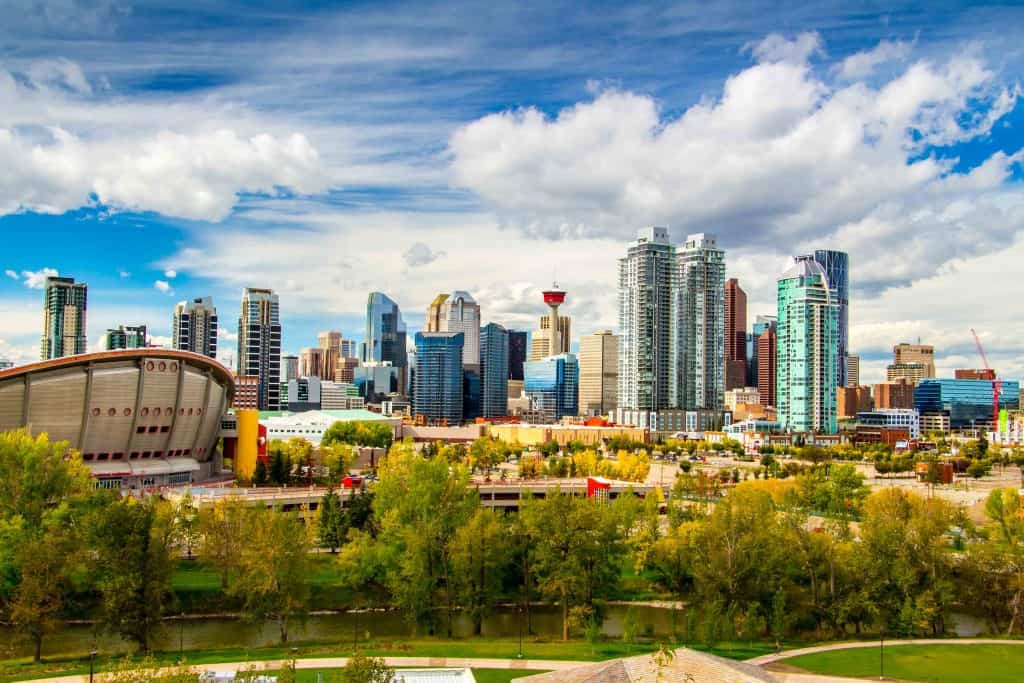
The decision to move to Canada can be life-changing. But the country is a big place and there are a lot of potential cities you could choose to call home. The city you select will play a big part in your financial success and how your life will unfold in the future. Calgary, Alberta is one of the many major cities in Canada to consider.
Is Calgary the right city for you? Maybe or maybe not. Researching each potential landing spot for you is essential. You need to be aware of the local job market, and housing options, and decide if it makes sense for your family.
Advertisement:
Prepare for Canada can guide you with helpful information about living in Calgary.
About Calgary, Alberta
Advertisement:
Calgary is a diverse and prosperous city in the province of Alberta. It sits in the foothills of the Rocky Mountains, where the Bow and Elbow rivers meet. Calgary enjoys more days of sunshine than any other major Canadian city and is less than an hour’s drive from the majestic Rockies. It offers fresh air, open spaces, parks and pathways, and mountains and rivers.
The city has roots dating back to 1875 and it was officially named a town in 1884. Today it is the largest city in Alberta and the third-largest in Canada. Calgary is also the third-most ethnically diverse city in all of Canada. It has residents from over 200 ethnic backgrounds. It has one of the highest visible minority rates in Canada, behind only Toronto and Vancouver. Most Calgary residents are of European origin. Many immigrants are attracted to Calgary, because of the low tax rate, strong oil and gas and agriculture industries and above all, the lifestyle it offers.
How Many People Live in Calgary, Alberta?
Calgary is a large city. The Calgary Census Metropolitan Area (CMA) population is about 1,581,000 as of 2021. The CMA includes the City of Calgary and its suburban areas. There are over 400,000 immigrants who call the city home.
It has one of the fastest growth rates in Canada. The city experienced a population growth of 5.5% from 2016 to 2021 and it continues to expand at a rapid pace.

How to Find a Job & Build a Career in Calgary
Calgary’s Local Economy
The city is recognized as the capital of the Canadian oil and gas industry. It is home to many of Canada’s oil and gas producers and is the decision-making hub and head office location of every energy company doing business in this country. As well, Calgary is becoming a global energy centre, with companies and organizations working in alternative energies, green power, and environmental technologies. Many financial businesses have grown up around these energy companies. Small business and self-employment levels also rank among the highest in Canada.
Advertisement:
Career Pathways in Calgary
Calgary is focused on the digital transformation of its industries. From 2021 to 2024, businesses in the city will spend an estimated $7.5 billion across all industries on digital transformation.
The main sectors of focus include:
- Aerospace
- Energy & Environment
- Digital Media & Entertainment
- High-tech manufacturing
- Financial services
- Life sciences
- Technology
- Transportation and logistics
- Tourism.
Major Employers in Calgary
Calgary is known for its larger employers in the oil and gas industry, such as BP Canada, and Imperial Oil. The other top employers in the region include:
- Canada Safeway Limited
- Westfair Foods Ltd.
- Canadian Natural Resources Limited
- Suncor Energy
- Agrium
- Flint Energy Services Ltd.
- Shaw Communication
- Canadian Pacific Railway
- WestJet
- Shell Canada
- Husky Energy.
Search for jobs through local recruiters such as BOWEN Group, About Staffing, Randstad Canada, Manpower, and TAG Recruitment Group Inc.
Related Post:
Mechanical Engineers are in Demand in these Canadian Cities
For information, tools, free webinars, and more visit our Finding a Job in Canada resource page. Get the help you need to achieve your career goals in Canada!
The Calgary Housing Market
Securing a job and creating a career plan are essential for new immigrants. But you also need to find somewhere to live in Calgary. Finding a home in Calgary shouldn’t be too difficult, as there are plenty of options. You can consider short-term accommodation and rentals if you are not ready to buy just yet.
Is Housing Expensive in Calgary, Alberta?
Home purchase costs are less than in larger cities like Vancouver or Toronto. But Calgary is one of the more expensive cities to live in. Rental costs are quite high compared to other Canadian cities.
Where you choose to live within the city can have a large financial difference. Neighbourhoods such as Bayview, Parkdale, Roxboro, and Elbow Park are expensive. The more affordable areas include Deer Ridge, Renfrew, Evanston, Rocky Ridge, and Coach Hill.
Finding a Place to Rent in Calgary
Rental rates are higher than the provincial average in Alberta. You can expect to pay anywhere from $1,000 to $1,700 or more. The average apartment for rent in Calgary is $1084 for a Bachelor, $1178 for a 1 Bedroom, $1460 for a 2 Bedroom, and $1698 for a 3 Bedroom.
The top areas to look for rental units include Castleridge, Mission, Cambrian Heights, Erlton, Whitehorn, and Highwood.
Use Rentals for Newcomers to search for available rental units in Calgary. Here, you can also find current rental prices in Calgary.
As a renter, it is important to protect your personal belongings. Consider buying  to protect your family, belongings, and finances. While renters’ insurance is optional, landlords may insist that you have it. Your landlord’s insurance policy will not cover you. Get more information about renting a home: Renting in Canada: What Newcomers Need to Know
to protect your family, belongings, and finances. While renters’ insurance is optional, landlords may insist that you have it. Your landlord’s insurance policy will not cover you. Get more information about renting a home: Renting in Canada: What Newcomers Need to Know

Buying a Home in Calgary
Buying a home in Calgary is considerably more affordable than buying in Ontario or British Columbia. But it is still more expensive than in other cities across Canada.
According to Royal LePage, the average cost to buy a home in Calgary increased by 9.9% year over year in 2021. The median cost to buy a home in Calgary is $572,200 (Q3, 2021). This is lower than the average price in the country. The median price to buy a detached single-family home is $643,700.
The median price to buy a condo is $225,800. This is a more affordable choice for new immigrants who are first-time home buyers. Find out more about buying your first home in Canada: First Time Home Buyer: Newcomer Tips
Driving & Transportation in Calgary
Driving in Calgary, Alberta
Calgary is located along the Trans-Canada Highway and Highway 2. It is a hub that is part of the CANAMEX corridor. There is a lot of commercial traffic in the area. The city uses a numbered street system laid out on a grid; streets run north-south, while avenues run east-west. The street numbers radiate outwards from the city centre.
With frigid winter weather and the potential for extreme conditions, drivers need to learn how to drive in the winter. You can get your learner’s permit when you are 14. Alberta uses a graduated licensing system, and you need to have a Class 5 driver’s licence to be considered fully licenced. In total, there are 7 classes of licenses. For more information, see:
Driving in Canada: 10 Essential Facts to Know.
Driving Test in Canada: A Full Guide
Tips for Winter Driving to Ensure Your Safety
Get YourAlberta Driving Licence
Calgary Public Transit
Calgary Transit offers public transit services across the city with buses, shuttle buses and light rail (C-Train). The light rail network is the backbone of the system. The convenient system can serve all of your transit needs, is cost-effective, and also helps to keep the city green.
To learn more, check out Public Transport in Calgary | Tips for Newcomers.
Calgary International Airport (YYC), in the city’s northeast, is a transportation hub for much of central and western Canada. The city’s presence on the Trans-Canada Highway and the Canadian Pacific Railway (CPR) mainlines also make it an important hub for freight.
Community Support for Newcomers
Calgary is one of the most diverse cities in Canada. It welcomes newcomers from different countries around the world. Immigrants have access to a variety of services and programs to help them acclimate to the region. You can get support for moving, finding housing, job searching, language skills, and much more.
Immigrant Services Calgary is a top resource for immigrants coming to the city.
Other top organizations to use include the Centre for Newcomers, the Calgary Catholic Immigration Society, the Calgary Immigrant Women’s Society, and The Immigrant Educational Society. Click here for a full list of support services. Learn more about Services in Canada to Help Newcomers Settle.
Language Support in Calgary
Immigrant Services Calgary offers a variety of free language support services for immigrants. You can also get language support from other organizations. They include YWCA Calgary, CIWA, and Language Instruction for Newcomers to Canada (LINC) through The Immigration Education Society.
Personal Finance & Banking
All local banks and credit unions as well as other financial institutions in Calgary have programs to help newcomers. You can open a bank account, get a credit card, or line of credit, and apply for a mortgage. Visit a local bank branch to start the process.
Get more banking tips for newcomers:
Top 10 Financial Steps to Take Before You Leave for Canada
Move to Canada | Transferring Cash & Valuables
Open a Bank Account Before Arriving in Canada
Calgary’s Education System

Calgary offers a wealth of options when it comes to schools in the city: public, Catholic, francophone, bilingual, language immersion, private, charter, religious-, sports-, arts-, music-, and science-focused.
The city offers as well childcare and preschool options. If you have a lower income, you may be eligible for government help to cover the costs of childcare. To find Calgary daycares, pre-schools, family day homes, out-of-school care, or group family child care, the government has a great child care search tool.
As home to more immigrants than any other community in Alberta, Calgary offers many English as a second language (ESL) schools in the city. Most immigrant-serving centres and organizations also provide ESL classes, while there are programs in place for younger students within both the public and Catholic school systems.
Elementary and High School Education
There are more than 100,000 children enrolled in 247 schools, including 27 senior high schools, run by the Calgary Board of Education.
Close to 59,000 students in 11 schools are enrolled through the Calgary Catholic School Board. This included 14 high schools and elementary and elementary junior high schools.
Post Secondary Institutions
Calgary offers a variety of post-secondary education options. The University of Calgary is the largest school in the city. Other schools include Mount Royal University, SAIT, and Athabasca University (online). Other colleges have campuses in the city.
Read more about education in Canada:
Schooling in Canada | A Look at the Education System
Higher Education Offers Benefits to Newcomers
Where to Get Medical Care in Calgary, Alberta
Calgary has four major adult acute care hospitals and one major pediatric acute care site: Alberta Children’s Hospital, Foothills Medical Centre, Peter Lougheed Centre, Rockyview General Hospital, and South Health Campus.
Calgary is also home to the leading cancer centre in Alberta, the Tom Baker Cancer Centre. The four largest Calgary hospitals have a combined total of more than 2,100 beds and employ over 11,500 people.
In addition to these centres, you will find other care centres, as well as hundreds of smaller medical and dental clinics operating in the city. Residents can pay for additional  . For prescription drugs and services that are not offered through Alberta Health Services.
. For prescription drugs and services that are not offered through Alberta Health Services.
In case of an emergency call 9-1-1. This number is the same no matter where you live in Canada.
Related Post:
Alberta Health Card | What it Covers & How to Apply
How to Find A Family Doctor In Calgary
One of the first steps you need to take after arriving in Calgary is finding a family doctor or specialist who has experience with a specific condition. The College of Physicians and Surgeons of Alberta provides a very handy online search tool that you can use to find a doctor in Calgary.
If you are unable to find a family doctor, you can go to one of many general non-emergency walk-in clinics in the city. Get more information about health care in Canada: Steps to Access Free Health Care in Canada
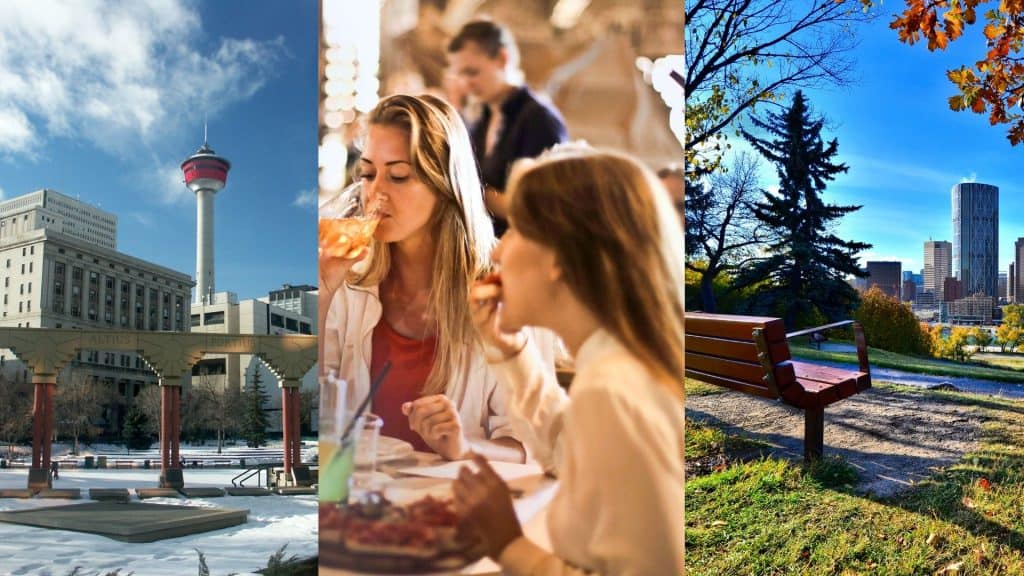
What is Day-to-Day Life Like in Calgary?
Things to Do in Calgary
Calgary is a unique city. It’s modern but still has roots in cowboy culture. The city is best known for the Calgary Stampede, which is an annual event occurring each July since 1912. It is one of Canada’s largest festivals, with over 1 million people visiting it every year.
Due to its proximity to the Rocky Mountains, the city has traditionally been a popular destination for winter sports. And after hosting the 1988 Winter Olympics, Calgary is now home to several major winter sporting facilities such as Canada Olympic Park and the Olympic Oval.
Public Spaces & Attractions
Calgary is the site of the Southern Alberta Jubilee Auditorium performing arts, culture, and community facility, which is the resident home of the Alberta Ballet Company, the Calgary Opera, and many other cultural ceremonies. The city is also home to several theatre companies.
Calgary hosts annual festivals and events, such as the Calgary International Film Festival, the Calgary Folk Music Festival, Wordfest: Banff Calgary International Writers Festival, Expo Latino, Calgary Pride, and other cultural and ethnic festivals.
Restaurants & Nightlife
The city has many multicultural areas where you can find a variety of ethnic restaurants and stores. Downtown Calgary is the prime destination for restaurants and nightlife.
Nature & Natural Landscapes
The city has many urban parks including Fish Creek Provincial Park; Bowness Park, Edworthy Park, the Inglewood Bird Sanctuary, Confederation Park, Prince’s Island Park, and Nose Hill Park, which is the largest municipal park in Canada.
Sporting Events & Concerts
Calgary is an Olympic city. It is home to the Calgary Flames hockey team and the Calgary Stampeders football team. The city regularly hosts international winter sporting events at its Olympic facilities. The city is also a regular stop for international musicians and events.
Culture & Diversity in Calgary
Diversity
Calgary is one of the most diverse cities in Canada. More than 400,000 immigrants are living in the city (2016 Census) and this number continues to climb. More than 20,000 new immigrants move to this city each year.
Immigrants account for one-third of the workforce in the city. More than 40% of newcomers work in manufacturing. Immigrants account for 42% of all workers in tourism, accommodation, and food services.
60% of Calgary’s population has European heritage. Other well-represented minorities include South Asian (9.5%), Chinese (6.8%), Filipinos (5.5%), Caribbean (5.4%), and Middle Eastern (3.5%) About 4% of the population in the city have Aboriginal heritage.
Related Post:
Places of Worship
In keeping with the multicultural makeup of Calgary, the city is home to many faith communities. To find places of worship, click here.
The Weather in Calgary
Close to the Rocky Mountains, Calgary experiences a dry, humid continental climate, with long, cold, dry, but variable winters, and short, moderately warm summers.
The city is among the sunniest in Canada however, with an average of 332.9 days every year. Even on cold, snowy days, you may still feel warmed by the sun. The average temperature ranges from a January daily average of −8.9 °C to a July daily average of 16.2 °C.
The chinook is a distinctive characteristic of the Calgary winters which can be uncomfortably cold sometimes. The Chinook is a warm, moist wind from the Pacific Ocean that may raise the temperature by as much as 15 degrees in a few hours.
Common Questions Immigrants Ask About Living in Calgary
Is Calgary A Good Place To Live?
Calgary is one of the top cities to live in Canada. It is consistently ranked as one of the most livable cities in the world. It has a diverse population and economy. Housing prices are considerably more affordable than in other major cities in Canada and around the world, and you have access to quality academic institutions. It is an Olympic city with close access to some of the most beautiful landscapes in the world.
Related Posts:
What to Know About Living in Fort McMurray, Alberta
What to Know About Living in Lethbridge, Alberta
Is Calgary Better Than Edmonton for Newcomers?
It depends on many unique factors. Calgary could be a better choice for you, or it may not. Your career aspirations, job opportunities, financial situation, and other things must be considered. Take time to compare what Edmonton has to offer before you make a final decision.
What are the Pros and Cons of Living in Calgary?
There are advantages to choosing to move to Calgary. The most notable are affordable housing, low sales tax, and job opportunities and it is an outdoor lover’s paradise. The most commonly cited drawback of moving to Calgary is the weather. It gets extremely cold during the winter and the region is known for extreme weather events such as forest fires and flooding.
For more information, tools, and free webinars about living in Canada visit our Settling in Canada resource page. We’ll help you to settle successfully!
